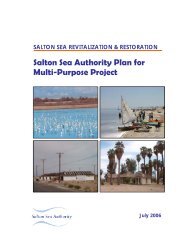- Page 1: R E P O R TPreliminary In-Sea Geote
- Page 4 and 5: TABLE OF CONTENTSSection 5 Prelimin
- Page 6 and 7: List of Acronyms and AbbreviationsA
- Page 8 and 9: Executive Summarysusceptible to sei
- Page 10 and 11: SECTIONONEIntroductionvarious resto
- Page 12 and 13: SECTIONTWOPreliminary Geotechnical
- Page 14 and 15: SECTIONTWOPreliminary Geotechnical
- Page 16 and 17: SECTIONTHREESite ConditionsThe Salt
- Page 18 and 19: SECTIONTHREESite Conditions3.4 SUBB
- Page 20 and 21: SECTIONTHREESite ConditionsVery lit
- Page 22 and 23: SECTIONFOURPotential Geologic And S
- Page 24 and 25: SECTIONFIVEPreliminary Engineering
- Page 26 and 27: SECTIONFIVEPreliminary Engineering
- Page 28 and 29: SECTIONFIVEPreliminary Engineering
- Page 30 and 31: SECTIONFIVEPreliminary Engineering
- Page 32 and 33: SECTIONSIXPreliminary Embankment De
- Page 36 and 37: SECTIONSEVENFurther StudiesSECTION
- Page 38 and 39: SECTIONSEVENFurther Studiesparamete
- Page 40 and 41: SECTIONNINEReferencesSECTION 9REFER
- Page 42 and 43: SECTIONNINEReferencesRoberston, P.K
- Page 44 and 45: TablesTable 1Summary of In-Sea Expl
- Page 46 and 47: TablesTable 3Summary of Material Pr
- Page 48 and 49: TablesTable 4 (continued)Summary of
- Page 50 and 51: TablesTable 5Summary of Consolidate
- Page 52 and 53: TablesTable 7Recent Large Earthquak
- Page 54 and 55: TablesTable 9Results of Preliminary
- Page 56 and 57: TablesTable 10Results of Prelimary
- Page 58: FiguresW:\27663042\00005-c-r.doc\1-
- Page 62 and 63: Standard penetration samplePunch Co
- Page 74 and 75: 00 10 20 30 40 50 60102030405060708
- Page 76 and 77: 00 10 20 30 40 50 60 70 80 90 10051
- Page 78 and 79: 8070CH or OH60U-line50Plasticity In
- Page 80: C u (psf)0 500 1,000 1,500 2,000 2,
- Page 83 and 84: APPENDIXAIn-Sea BoringsW:\27663042\
- Page 85 and 86:
APPENDIXAIn-Sea BoringsPortions of
- Page 87 and 88:
Project: Salton Sea RestorationProj
- Page 89 and 90:
Project: Salton Sea RestorationProj
- Page 91 and 92:
Project: Salton Sea RestorationProj
- Page 93 and 94:
Project: Salton Sea RestorationProj
- Page 95 and 96:
Project: Salton Sea RestorationProj
- Page 97 and 98:
Project: Salton Sea RestorationProj
- Page 99 and 100:
Project: Salton Sea RestorationProj
- Page 101 and 102:
Project: Salton Sea RestorationProj
- Page 103 and 104:
Project: Salton Sea RestorationProj
- Page 105 and 106:
Project: Salton Sea RestorationProj
- Page 107 and 108:
Project: Salton Sea RestorationProj
- Page 109 and 110:
APPENDIXBIn-Sea Cone Penetration Te
- Page 116 and 117:
Depth (ft)0-10-20-30-40-50-60qt (ts
- Page 118 and 119:
Depth (ft)0-10-20-30-40-50-60qt (ts
- Page 120 and 121:
Depth (ft)0-10-20-30-40-50-60qt (ts
- Page 122 and 123:
Depth (ft)0-10-20-30-40-50-60qt (ts
- Page 124 and 125:
Depth (ft)0-10-20-30-40-50-60qt (ts
- Page 126 and 127:
Depth (ft)0-10-20-30-40-50-60qt (ts
- Page 128 and 129:
Depth (ft)0-10-20-30-40-50-60qt (ts
- Page 130 and 131:
Depth (ft)0-10-20-30-40-50-60qt (ts
- Page 132 and 133:
Depth (ft)0-10-20-30-40-50-60qt (ts
- Page 134 and 135:
Depth (ft)0-10-20-30-40-50-60qt (ts
- Page 136 and 137:
Depth (ft)0-10-20-30-40-50-60qt (ts
- Page 138 and 139:
Depth (ft)0-10-20-30-40-50-60qt (ts
- Page 140 and 141:
Depth (ft)0-10-20-30-40-50-60qt (ts
- Page 142 and 143:
Depth (ft)0-10-20-30-40-50-60qt (ts
- Page 144 and 145:
Depth (ft)0-10-20-30-40-50-60qt (ts
- Page 146 and 147:
Depth (ft)0-10-20-30-40-50-60qt (ts
- Page 148 and 149:
Depth (ft)0-10-20-30-40-50-60qt (ts
- Page 226 and 227:
APPENDIXCLaboratory TestingW:\27663
- Page 228 and 229:
APPENDIXCLaboratory TestingTable C-
- Page 230 and 231:
APPENDIXCLaboratory TestingTable C-
- Page 232 and 233:
SAMPLE PHOTOGRAPHSSOFT LACUSTRINE D
- Page 234 and 235:
SAMPLE PHOTOGRAPHSUPPER STIFF LACUS
- Page 236 and 237:
SAMPLE PHOTOGRAPHSLOWER STIFF LACUS
- Page 238 and 239:
00 5 10 15 20 25 30 35 40 45 50 55
- Page 240 and 241:
00 5 10 15 20 25 30 35 40 45 50 55
- Page 242 and 243:
0Water Content (percent of dry weig
- Page 244 and 245:
Water Content (percent of dry weigh
- Page 246 and 247:
0Water Content (percent of dry weig
- Page 361 and 362:
APPENDIXDStatic Slope Stability Ana
- Page 363 and 364:
150100500-50-100-150-200-250-300-35
- Page 365 and 366:
150100500-50-100-150-200-250-300-35
- Page 367 and 368:
300-200 -150 -100 -50 0 50 100 150
- Page 369 and 370:
300-200 -150 -100 -50 0 50 100 150
- Page 371 and 372:
150100500-50-100-150-200-250-300-35
- Page 373 and 374:
150100500-50-100-150-200-250-300-35
- Page 375 and 376:
300-200 -150 -100 -50 0 50 100 150
- Page 377 and 378:
5004003002001000-100-200-300-400-50
- Page 379 and 380:
5004003002001000-100-200-300-400-50
- Page 381 and 382:
5004003002001000-100-200-300-400-50
- Page 383 and 384:
150100500-50-100-150-200-250-300-35
- Page 385 and 386:
150100500-50-100-150-200-250-300-35
- Page 387 and 388:
150100500-50-100-150-200-250-300-35
- Page 389 and 390:
150100500-50-100-150-200-250-300-35
- Page 391 and 392:
150100500-50-100-150-200-250-300-35
- Page 393 and 394:
150100500-50-100-150-200-250-300-35
- Page 395 and 396:
5004003002001000-100-200-300-400-50
- Page 397 and 398:
5004003002001000-100-200-300-400-50
- Page 399:
5004003002001000-100-200-300-400-50



